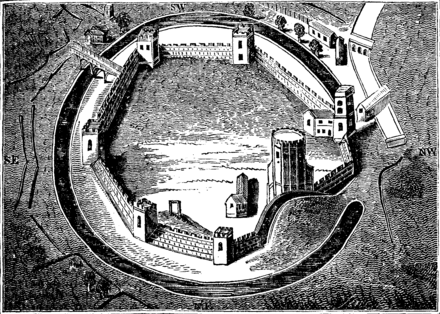
The siege of Oxford took place during the Anarchy—a period of civil war following the death of Henry I of England without a male heir—in 1142. Fought between his nephew, Stephen of Blois, and his daughter, the Empress Matilda (or Maud),[note 1] who had recently been expelled from her base in Westminster and chosen the City of Oxford as her new headquarters. Oxford by now was effectively a regional capital and important in its own right. It was a well-defended city with both rivers and walls protecting it, and was also strategically important as it was at a crossroads between the north, south-east and west of England, and also not far from London.
By now the civil war was at its height, yet neither party was able to get an edge on the other: both had suffered swings of fate in the last few years which had alternately put them ahead, and then behind, their rival. Stephen, for instance, had been captured by Matilda's army in 1141, but later in the year, Matilda's half-brother and chief military commander, Robert, Earl of Gloucester was captured by Stephen's army. Likewise, Matilda had been recognised as "Lady of the English" but had not long afterwards been run out of London.
Stephen believed that all it would take to win the war decisively would be to capture Matilda herself; her escape to Oxford seemed to present him with such an opportunity. Having raised a large army in the north, he returned south and attacked Wareham in Dorset; this port town was important to Matilda's Angevin party as it provided one of the few direct links to the continent that they controlled. He attacked and captured more towns as he returned to the Thames Valley, and soon the only significant base Matilda had outside of the south-west—apart from Oxford itself—was at Wallingford Castle, held by her close supporter Brian Fitz Count.
Stephen's army approached Oxford in late September 1142, and according to contemporary accounts, swam his army across the rivers and waterways that blocked the approach to the city. Matilda's small force was taken by surprise. Those that were not killed or captured retreated into the castle; Stephen now controlled the city, which protected him from counterattack. The king knew he was unlikely to be able to take the castle by force—although that did not stop him from using the latest siege technology. He also knew that it would be a long, hard wait before Matilda was starved out. But after nearly three months of siege, conditions for the garrison were dire, and they formed a plan to help the Empress escape from under Stephen's nose. One early December evening Matilda crept out of a postern door in the wall—or, more romantically, possibly shinned down on a rope out of St George's Tower—dressed in white as camouflage against the snow and passed without capture through Stephen's lines. She escaped to Wallingford and then to Abingdon, where she was safe; Oxford Castle surrendered to Stephen the following day, and the war continued punctuated by a series of sieges for the next 11 years.
- ^ Redmonds 2004, p. 14.
- ^ Gee 2002, p. 6.
- ^ Tolhurst 2013, p. 39.
- ^ Fössel 2011, p. 163.
- ^ Huscroft 2005, p. xv.
Cite error: There are <ref group=note> tags on this page, but the references will not show without a {{reflist|group=note}} template (see the help page).